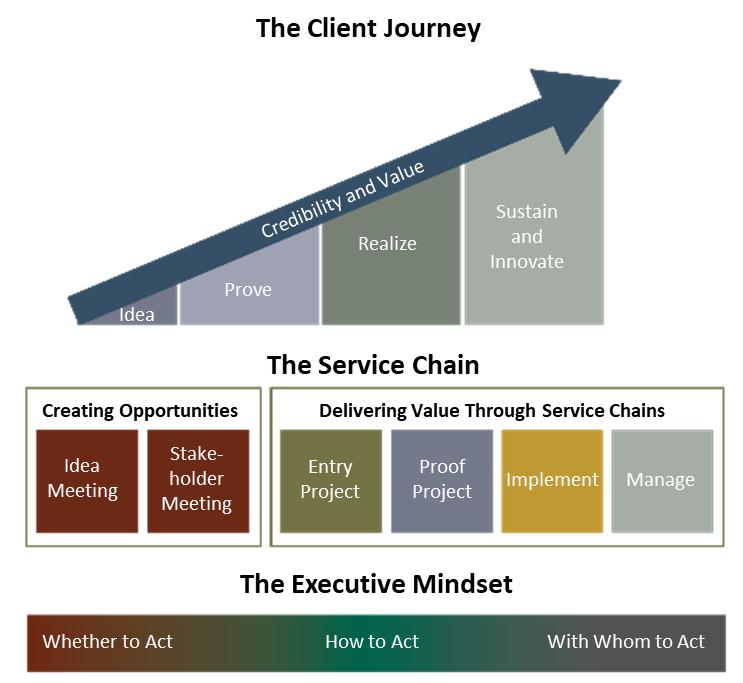This blog is part of a series on Service Chains. To read the first blog in the series, click here .
Our last post introduced the concept of the Service ChainSM. Remember the goal is to establish an executable and repeatable offering as the means to deliver on the full promise of the True SolutionSM or Service ChainSM with messaging that resonates in the market and addresses topics that executives are or should be interested in.
Now we will begin to break down the components and explore it in more detail.

This graphic represents the Service Chain with two boxes (meetings) in “Creating Opportunities” and four boxes (projects or phases) in “Delivering Value.” Not every sale is won with two meetings and not every offer has four distinct projects; in both cases, it may be more or less. Some common examples:
- The Implement Phase may contain multiple distinct projects, such as phased implementation in different parts of the organization or distinct modules of the solution
- Some offers are indirect (meaning they are not intended to pull through any other product or service); these offers may not have a manage phase
- If the size, urgency, and steps to realize an idea support it, some Service Chains move from an Entry Project to Implementation with the objectives and outcomes of the Proof Project incorporated into the Entry Project or early stages of the Implement Phase
- The diagnosis and agreement on the scope of a client’s challenge may be agreed upon during the Stakeholder Meeting. Thus, some of typical activities and objectives of an Entry Project may not be necessary and the first delivery project may look more like a Proof Project (although size and timing will need to address the Entry Project characteristics that we’ll describe later)
However, each step shown in the graphic has the explicit objectives and outcomes described below that must be achieved to move the buyer effectively through the decision (dating) process to the total solution (marriage). Service ChainsSM accomplish these objectives and outcomes by disaggregating the big purchase decision into smaller decisions scoped and sized to match the buyer’s position in the journey – the buyer’s investment grows as the understanding, credibility, and value achieved or achievable increases.
We’ll explore each of these projects or phases in more detail in a future post, but for now, here is a summary:
| Journey Step | Investment | Value Derived |
| Idea Meeting | 30 minutes to an hour of the buying executive’s time | Introduction to a concept that could provide value on an important topic |
| Stakeholder Meeting | A few hours of time from the core group of the executive’s peers or team members that would be impacted by the idea | Validation that the idea is worth exploring further within the organization, buy-in from key participants, and clarity on initial steps of the journey |
| Entry Project | Fees that are below the executive’s budgetary authority, but sufficient to attach importance to the effort for the executive and the organization; participation from key stakeholders | Certainty that the idea applies and warrants further investment to attain the benefits |
| Proof Project | More substantial fees and greater organization participation, but with limited organizational disruption of existing operations | Proof of concept and/or clarity of the path forward – ideally both |
| Implement Phase | Fees and organizational time/ disruption commensurate with the value to be achieved through the idea | Realization of the benefits and/or ability of the organization to do so |
| Manage Phase | Fees commensurate with on-going benefits | Continued realization of benefits, evolution of the organization’s application of the idea to be more efficient or effective, and identification of new opportunities |
A single well-executed Service Chain instills the seller with the freedom to continue bringing new ideas because of the credibility and executive access built along the journey. This is true even if the buyer exits the journey before it is complete because at no point along the path will the buyer be asked to make an uninformed decision – “to jump off a cliff” leaving them with buyer’s remorse and distrust of the sales and account team that brought them on the journey.
Let’s close with some of the pitfalls, obstacles, and challenges:
- Not charging for the Entry Project
- Selling an Entry Project during the “Creating Opportunities” phase, rather than building consensus for the Idea
- Failing to match the size, scope, or cost of any project in the Service Chain to the trust, credibility, and value achieved to date, and thus, to the buyer’s mindset
- Dividing the Service Chain into projects that do not have implicit, logical connections or linkages to the next project in the Service Chain
- Skipping a step in the Service Chain without fully addressing the objectives and outcomes tied to that step in some other fashion, thereby misaligning to the buyer’s decision process
- Not effectively selling the entire vision and future state, both at the beginning of the relationship and throughout the early parts of the engagement.
To read the next blog in this series, click here.
Written by: Doug Long
About the Author: Doug Long is a Partner with McMann & Ransford and has more than 26 years of experience in consulting across various industries, topics, and client challenges. Prior firms include Deloitte and GE. He currently leads our Healthcare Practice.
